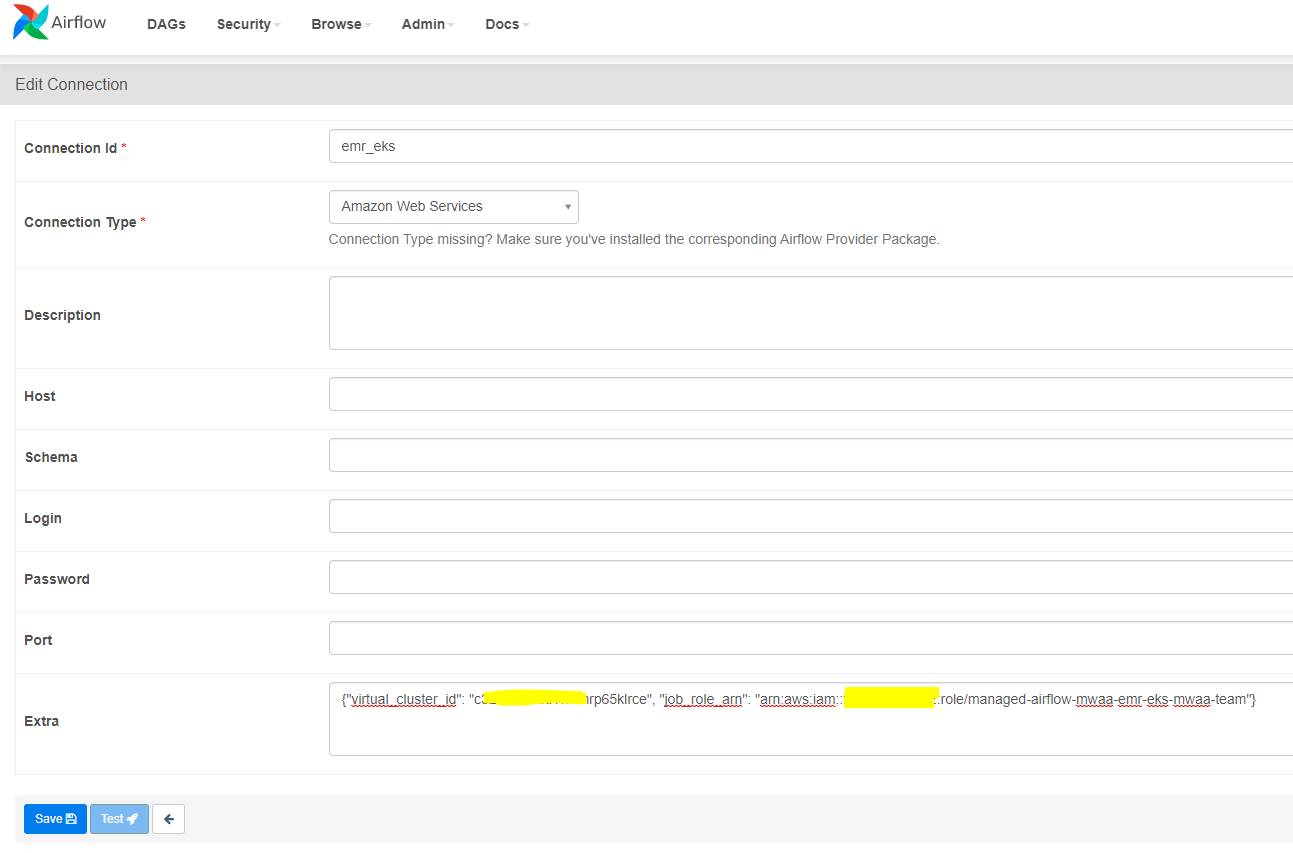Amazon Managed Workflows for Apache Airflow (MWAA)
Amazon Managed Workflows for Apache Airflow (MWAA) is a managed orchestration service for Apache Airflow that makes it easier to set up and operate end-to-end data pipelines in the cloud at scale. Apache Airflow is an open-source tool used to programmatically author, schedule, and monitor sequences of processes and tasks referred to as “workflows.” With Managed Workflows, you can use Airflow and Python to create workflows without having to manage the underlying infrastructure for scalability, availability, and security.
The example demonstrates how to use Amazon Managed Workflows for Apache Airflow (MWAA) to assign jobs to Amazon EKS in two ways.
- Directly create a job and deploy to EKS.
- Register EKS as a virtual cluster in EMR and assign a spark job to EMR on EKS.
Code repo for this example.
Considerations
Ideally we recommend adding the steps to sync requirements/sync dags to the MWAA S3 Bucket as part of a CI/CD pipeline. Generally Dags development have a different lifecycle than the Terraform code to provision infrastructure.
For simplicity, we are providing steps for that using Terraform running AWS CLI commands on null_resource.
Prerequisites:
Ensure that you have the following tools installed locally:
Deploy
To provision this example:
git clone https://github.com/awslabs/data-on-eks.git
cd data-on-eks/schedulers/terraform/managed-airflow-mwaa
chmod +x install.sh
./install.sh
Enter region at command prompt to continue.
Once done, you will see terraform output like below.
The following components are provisioned in your environment:
- A sample VPC, 3 Private Subnets and 3 Public Subnets
- Internet gateway for Public Subnets and NAT Gateway for Private Subnets
- EKS Cluster Control plane with one managed node group
- EKS Managed Add-ons: VPC_CNI, CoreDNS, Kube_Proxy, EBS_CSI_Driver
- K8S metrics server and cluster autoscaler
- A MWAA environment in version 2.2.2
- An EMR virtual cluster registered with the newly created EKS
- A S3 bucket with DAG code
Validate
The following command will update the kubeconfig on your local machine and allow you to interact with your EKS Cluster using kubectl to validate the deployment.
Run update-kubeconfig command
Run the command below. You may also copy the command from the terraform output 'configure_kubectl'.
aws eks --region us-west-2 update-kubeconfig --name managed-airflow-mwaa
List the nodes
kubectl get nodes
# Output should look like below
NAME STATUS ROLES AGE VERSION
ip-10-0-0-42.ec2.internal Ready <none> 5h15m v1.26.4-eks-0a21954
ip-10-0-22-71.ec2.internal Ready <none> 5h15m v1.26.4-eks-0a21954
ip-10-0-44-63.ec2.internal Ready <none> 5h15m v1.26.4-eks-0a21954
List the namespaces in EKS cluster
kubectl get ns
# Output should look like below
default Active 4h38m
emr-mwaa Active 4h34m
kube-node-lease Active 4h39m
kube-public Active 4h39m
kube-system Active 4h39m
mwaa Active 4h30m
namespace emr-mwaa will be used by EMR for running spark jobs.
namespace mwaa will be used by MWAA directly.
Trigger jobs from MWAA
Log into Apache Airflow UI
- Open the Environments page on the Amazon MWAA console
- Choose an environment
- Under the
Detailssection, click the link for the Airflow UI
Note: You will see red error message once login. That is because the EMR connection has not been setup. The message will be gone after following the steps below to set up the connection and login again.
Trigger the DAG workflow to execute job in EMR on EKS
First, you need to set up the connection to EMR virtual cluster in MWAA

- Click Add button,
- Make sure use
emr_eksas Connection Id Amazon Web Servicesas Connection Type- Replace the value in
Extrabased on your terraform output
{"virtual_cluster_id":"<emrcontainers_virtual_cluster_id in terraform output>", "job_role_arn":"<emr_on_eks_role_arn in terraform output>"}

Go back to Airflow UI main page, enable the example DAG emr_eks_pi_job and then trigger the job.

While it is running, use the following command to verify the spark jobs:
kubectl get all -n emr-mwaa
You should see output similar to the following:
NAME READY STATUS RESTARTS AGE
pod/000000030tk2ihdmr8g-psstj 3/3 Running 0 90s
pod/pythonpi-a8051f83b415c911-exec-1 2/2 Running 0 14s
pod/pythonpi-a8051f83b415c911-exec-2 2/2 Running 0 14s
pod/spark-000000030tk2ihdmr8g-driver 2/2 Running 0 56s
NAME TYPE CLUSTER-IP EXTERNAL-IP PORT(S) AGE
service/spark-000000030tk2ihdmr8g-ee64be83b4151dd5-driver-svc ClusterIP None <none> 7078/TCP,7079/TCP,4040/TCP 57s
NAME COMPLETIONS DURATION AGE
job.batch/000000030tk2ihdmr8g 0/1 92s 92s
You can also check the job status in Amazon EMR console. Under the Virtual clusters section, click on Virtual cluster

Trigger the DAG workflow to execute job in EKS
In the Airflow UI, enable the example DAG kubernetes_pod_example and then trigger it.


Verify that the pod was executed successfully
After it runs and completes successfully, use the following command to verify the pod:
kubectl get pods -n mwaa
You should see output similar to the following:
NAME READY STATUS RESTARTS AGE
mwaa-pod-test.4bed823d645844bc8e6899fd858f119d 0/1 Completed 0 25s
Destroy
To clean up your environment, run the cleanup.sh script.script
chmod +x cleanup.sh
./cleanup.sh